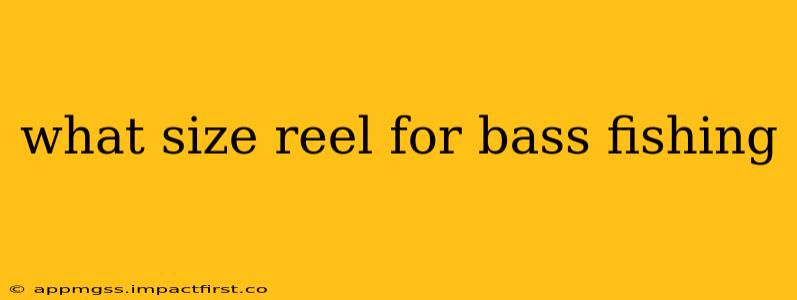What Size Reel for Bass Fishing? Finding the Perfect Match for Your Rod and Technique
Choosing the right reel size for bass fishing is crucial for a successful and enjoyable experience. The ideal size depends on several factors, including the type of bass you're targeting, your fishing technique, and the rod you're using. This guide will help you navigate the world of reel sizes and find the perfect match for your needs.
Understanding Reel Sizes:
Reel sizes are typically denoted by a number, such as 2000, 3000, or 4000. These numbers don't represent a specific measurement but rather indicate the reel's capacity and gear ratio. Generally, higher numbers indicate larger reels with more line capacity and potentially a higher gear ratio. However, manufacturers' sizing systems can vary slightly, so it's always best to check the specifications provided by the manufacturer.
What size reel do I need for bass fishing?
This is a common question, and the answer isn't a single number. The best size depends on your specific setup and fishing style. Here's a breakdown:
-
Light Tackle (finesse fishing): For finesse techniques like drop-shotting, shaky head jigs, and small crankbaits targeting smaller bass or in pressured waters, a smaller reel size, such as a 2000-2500 size, is ideal. These reels are lightweight and provide good sensitivity, allowing you to feel subtle bites.
-
Medium Tackle (versatile): A medium-sized reel, usually in the 3000-4000 range, is a versatile option suitable for a wide range of bass fishing techniques. It handles a variety of lures and lines well, making it a popular choice for many anglers. This size is a good all-around choice for many bass fishing situations.
-
Heavy Tackle (power fishing): For big bass and heavy lures like large crankbaits, spinnerbaits, and swim jigs, a larger reel (4000-6000) provides the necessary power and line capacity. These reels are built to handle the strain of fighting larger fish and retrieving heavy lures.
How much line capacity do I need?
Line capacity is another important consideration. You'll want enough line to handle the average size of the bass in your target waters, and you also need to consider the type of line you are using. Thicker lines have less capacity than thinner lines. Check the reel's specifications to ensure it holds sufficient line for your needs. You'll want enough line to make a long cast and to fight a fish without running out of line.
What about gear ratio?
Gear ratio refers to the number of times the spool rotates for every turn of the handle. A higher gear ratio (e.g., 7:1) means faster retrieve speeds, ideal for covering water quickly with crankbaits. A lower gear ratio (e.g., 5:1) provides more power for fighting larger fish and retrieving heavy lures. Consider your preferred fishing style when selecting a gear ratio.
What type of bass are you targeting?
The size of bass you typically target will influence your reel choice. If you're targeting smaller largemouth or spotted bass, a smaller reel might suffice. However, if you regularly pursue trophy-sized bass, you'll need a larger reel with sufficient line capacity and power.
How does reel size relate to rod power?
Your reel should be appropriately matched to the power of your rod. A lightweight reel on a heavy-power rod will feel unbalanced, and vice-versa. The manufacturer's recommendations for the rod will often provide guidance on suitable reel sizes.
By considering these factors, you can choose the right reel size for your bass fishing adventures. Remember to prioritize balance, comfort, and the ability to handle the specific techniques and fish you're targeting. Happy fishing!
